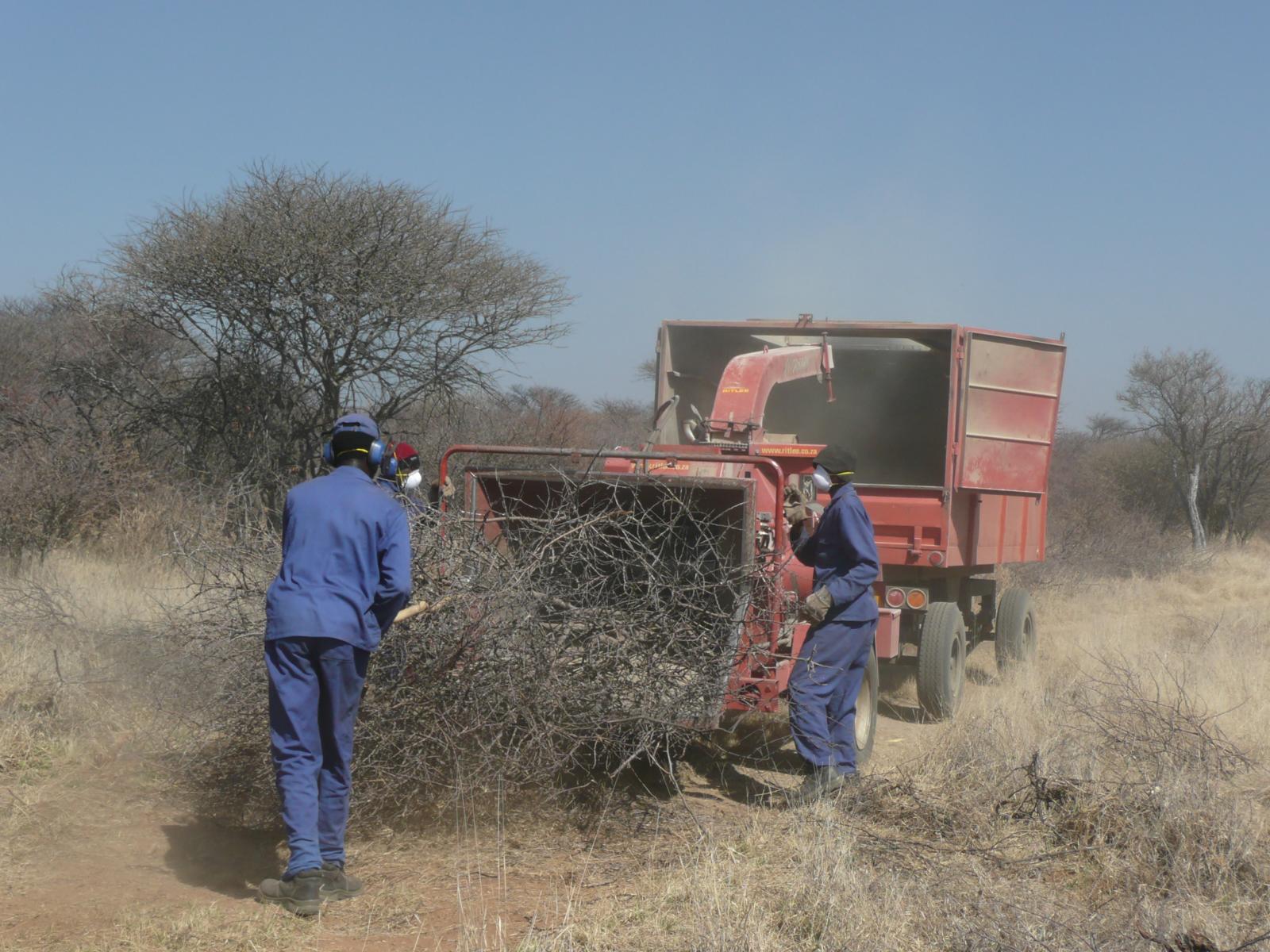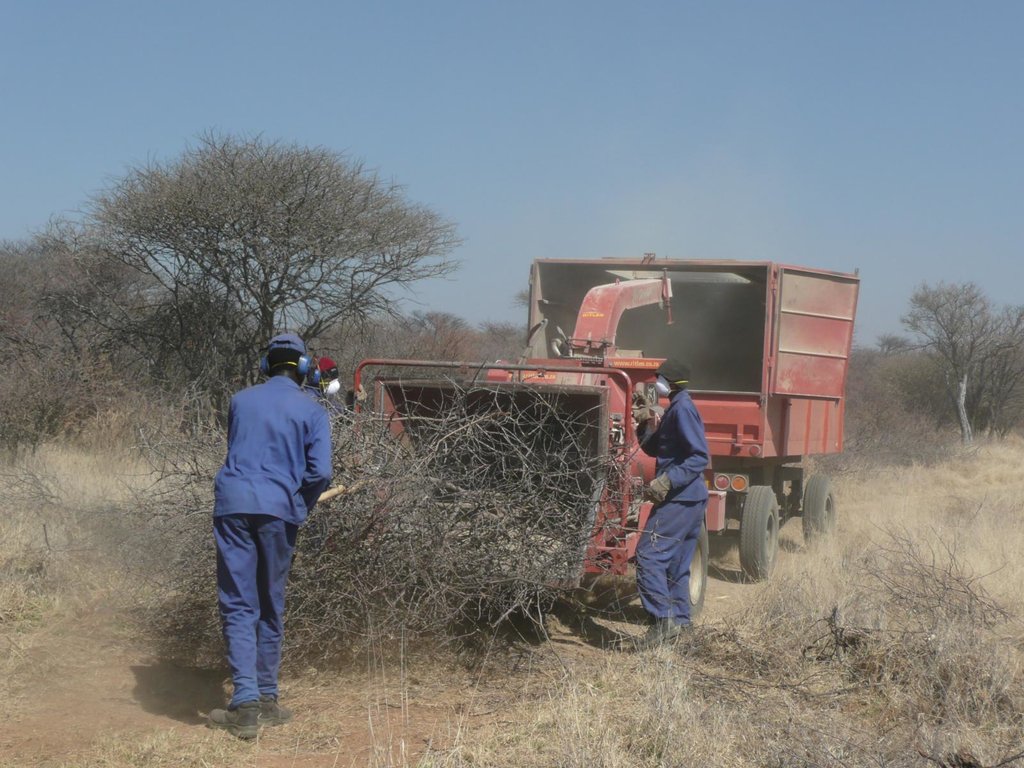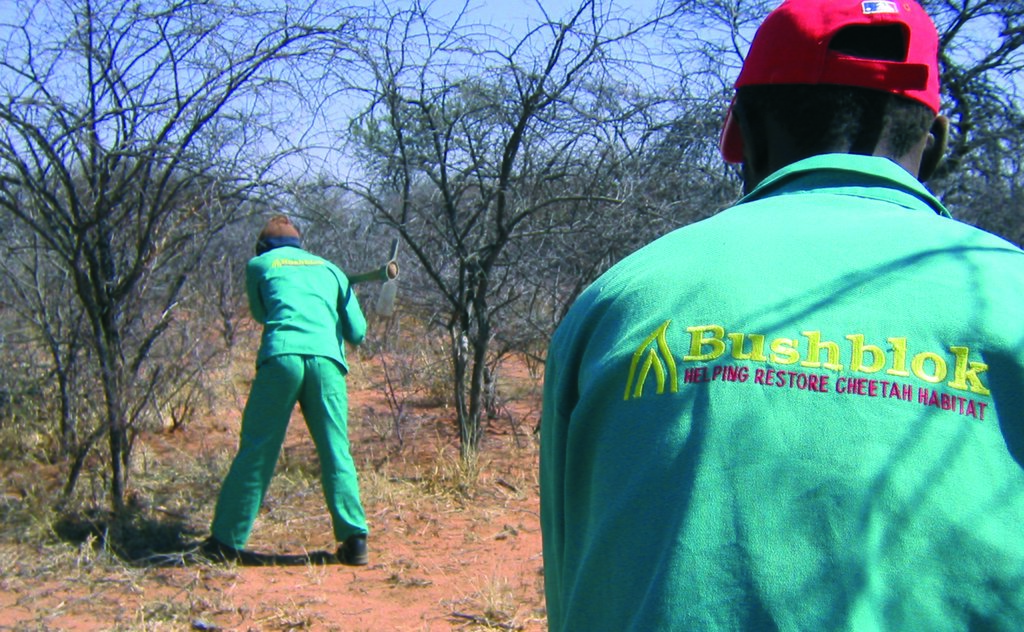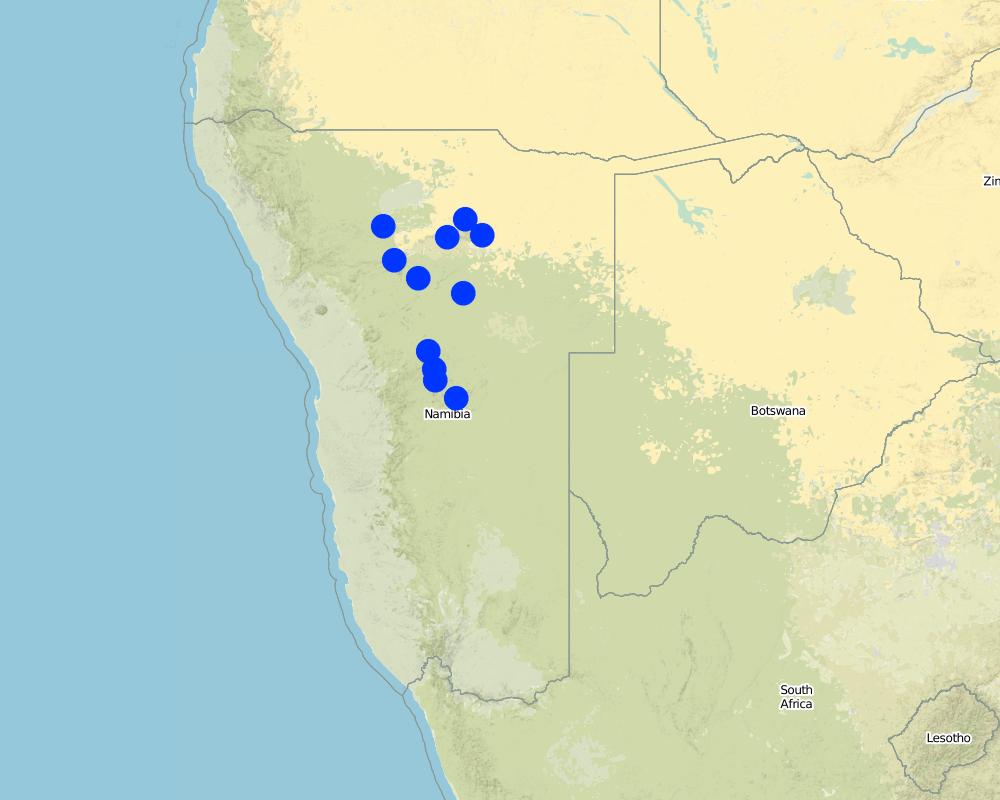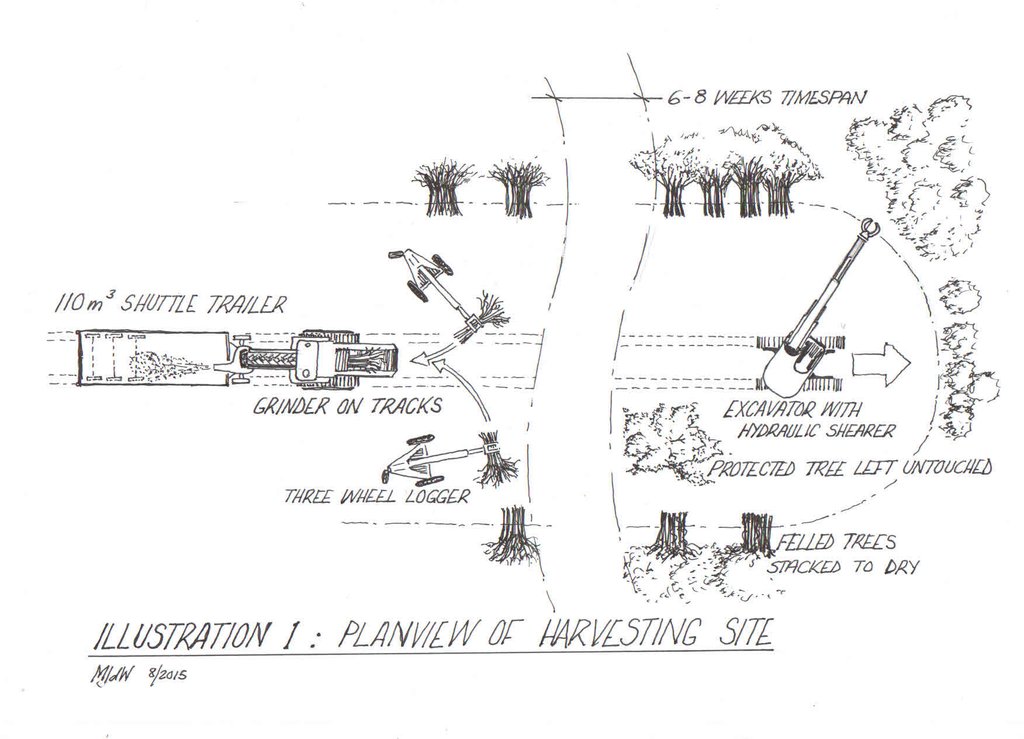Bush Thinning and Biomass Processing by Manual or Mechanised Means [Намибия]
- Создание:
- Обновить:
- Составитель: Johannes Laufs
- Редактор: –
- Рецензент: Rima Mekdaschi Studer
De-bushing
technologies_2203 - Намибия
- Полная аннотация в формате PDF
- Полная аннотация в формате PDF для вывода на печать
- Полная аннотация в формате интернет-страницы
- Полная аннотация (неотформатированно)
- Bush Thinning and Biomass Processing by Manual or Mechanised Means: 17 июля 2018 г. (inactive)
- Bush Thinning and Biomass Processing by Manual or Mechanised Means: 31 мая 2019 г. (inactive)
- Bush Thinning and Biomass Processing by Manual or Mechanised Means: 22 августа 2017 г. (inactive)
- Bush Thinning and Biomass Processing by Manual or Mechanised Means: 2 ноября 2021 г. (public)
- Bush Thinning and Biomass Processing by Manual or Mechanised Means: 21 февраля 2018 г. (inactive)
Просмотреть разделы
Развернуть все Свернуть все1. Общая информация
1.2 Контактные данные специалистов и организаций, участвующих в описании и оценке Технологии
Название организации (-ий), содействовавших документированию/оценке Технологии (если применимо)
Deutsche Gesellschaft für Internationale Zusammenarbeit (GIZ) GmbH (GIZ) - Германия1.3 Условия, регламентирующие использование данных, собранных ВОКАТ
Когда были собраны данные (на местах)?
01/08/2014
Составитель и ответственный(-ые) специалист(-ы) согласны с условиями, регламентирующими использование собранных ВОКАТ данных:
Да
1.4 Декларация по устойчивости описываемой Технологии
Вызывает ли описанная здесь Технология проблемы деградации земель настолько, что ее нельзя назвать природосберегающей?
Нет
Пояснения:
The technology described is a means to rehabilitate degraded rangeland. Through targeted harvesting of bushes, the bush density is reduced, allowing for better growth of grass.
1.5 Ссылка на Анкету (-ы) по Подходам УЗП
2. Описание Технологии УЗП
2.1 Краткое описание Технологии
Определение Технологии:
On Namibian farmland bushes are harvested in order to reduce the excessive bush densities, that stiffle the growth of other plant species, especially grasses. Bush can be harvested manually (e.g. with axes), semi-mechanised (e.g. chainsaws) or fully mechanised (e.g. customised excavators). After cutting, the bush is typically left to dry and in a second step processed into a transportable format (e.g. wood chips).
2.2 Подробное описание Технологии
Описание:
Bush thinning in the form of selective bush harvesting is applied on Namibian agricultural land. The main aim of the technology is the restoration of degraded rangeland, reducing bush densities, fostering the re-growth of grasses. According to the best available estimates about 45 million hectares of Namibian farmland are affected by bush encroachment. Bush encroachment negatively affects biodiversity, groundwater recharge and importantly the carrying capacity of rangeland. Bush encroachment equally hinders crop production, but this phenomenon is of less significance in Namibia due to the limited scope of crop production in the country. There is a multitude of causes for bush encroachment, among which overgrazing (i.e. overstocking with cattle or lack of rotational grazing), reduced frequency of wildfires and higher CO2 concentrations in the atmosphere feature strongly. Bush encroachment is not to be equated with the invations of alien species, since most encroacher species are indigeneous to Namibia
While it is believed that natural transitions in the ecosystems can on the long-run, under favourable climatic conditions, also lead to reductions of bush encroachment, active rehablitation measures are required in order to achieve improvements on the short-run. This is an aboslute necessity for many Namibian farmers, who experience severe economic difficulties due to the reduced productivity of their land.
Bush control comprises of responsive measures (bush thinning), follow-up measures (aftercare) as well as preventative measures (good rangeland management practices). Since vast areas of Namibian rangeland are heavily encroached by indigenous bush species, the focus is currently on responsive measures, i.e. bush thinning.
Bush thinning entails the practice of selectively harvesting a specified number of bushes, effectively reducing the number of bushes per given area. To determine the density of bush remaining after thinning, a formula based on tree equivalent (TE) and average annual rainfall is used. A tree equivalent is defined as a woody tree or bush of 1,5 metres in height. Thus, a 3 metre shrub would represent 2 TE, a 4.5 metre shrub 3 TE. As rule of thumb for estimating optimal bush density, about 30-35% of encroacher biomass should be removed. This rule is based on research that has been carried out mainly in South Africa over the past decades, measuring and comparing the re-growth experienced at various sites where bush had been harvested. Areas, in which too much bush was removed, experienced strong re-growth of bush, often resulting in even heavier bush encroachment.
Bush thinning follows strict environmental guidelines set by the Ministry of Environment and Tourism through the Environmental Management Act with regard to the equipment's used (avoiding negative side-effects such as disturbance of the soil) and the amount of bushes to be harvested (aiming at the right balance between reducing the encroachment and maintaining a healthy number of the desired bush species). The amount of bushes to be harvested must be determined by expert for each specific area and depends on various factors, e.g. soil type, topgraphy, severity of bush encroachment and intended land use type.
It is important to note, that as with most direct interventions in natural ecosystems, there is a lack of precise knowledge on the long-term effect of bush thinning and the appropriate intensity thereof. There is however no doubt that active bush control has an overall positive effect on the savanna ecosystem in Namibia.
In order to render bush thinning economically feasible, value chains have been developed. Through the processing and utilisation of the woody bush biomass, income can be generated and the cost of bush conrol balanced. Existing value chains include the production of charcoal, firewood, poles, bush based animal feed as well as heat and electricity. Value chains currently under development include composition materials, such as wood-plastic, wood-cement and bio-plastic.
Scientific observations have shown, that bush thinning cannot be implemented as a once-off activity, but requires regular follow-up to prevent the re-thickening of the bush. Follow-up measures (so-called aftercare) include the prevention of coppicing and re-growth. This can be achieved by applying aboricides selectively to the cut stems, stem fires or the introduction of browsers (e.g. goats). Research on the effectiveness and possible side effects of each of these methods is limited.
The need for bush control, and therewith bush thinning, is widely recognised among land owners and also acknowledged on the national political agenda.
A major challenge for the implementation of the technology is the limited suitability of available machines. The hardness and high mineral content of the woody biomass leads to high wear and tear on the equipment (both harvesting equipment and processing equipment, like chippers and pelletisers), often rendering operations unprofitable. Research into more suitable machinery is ongoing.
Further, the implementation of sustainable bush control must be improved through skills training and continuous monitoring of the long-term effects on rangeland.
2.3 Фотографии, иллюстрирующие Технологию
Комментарии к фотографиям:
All photos have either been taken by the GIZ Support to De-bushing Project or were provided to the project by third parties.
2.4 Видеоматериалы, иллюстрирующие Технологию
Комментарий, краткое описание:
https://www.youtube.com/watch?v=859GshR9hso&t=3s
Bush Encroachment in Namibia: Causes and Extent
An explanation of the root causes of bush encroachment and its impact on land in Namibia.
Дата:
01/11/2015
Место:
Namibia
Автор съемки:
GIZ Support to De-bushing Project
Комментарий, краткое описание:
https://www.youtube.com/watch?v=bmlzPDiqlxo&t=45s
Biomass Value Addition: Bush Based Products
An overview of existing and potential value chains based on encroacher bush.
Дата:
01/11/2015
Место:
Namibia
Автор съемки:
GIZ Support to De-bushing Project
Комментарий, краткое описание:
https://www.youtube.com/watch?v=MMSOfV2KBjA
Biomass Energy: From Bush to Electricity
Overview of the energetic applications of woody biomass from encroacher bush.
Дата:
01/11/2015
Место:
Namibia
Автор съемки:
GIZ Support to De-bushing Project
2.5 Страна/ регион/ места, где применяется Технология, информация о которых собрана в данной Анкете
Страна:
Намибия
Более точная привязка места:
Bush control is applied across Namibia on many privately owned farms. Activities are most concentrated in the regions Khomas, Omaheke, Otjozondjupa and Oshikoto.
Пояснения:
Pointers on the map only indicate points (e.g. urban centres) around which activities are concentrated. It is not possible to depict each site where bush control is implemented due to the high number of individual activities and projects.
Map
×2.6 Сколько лет применяется данная Технология
Год начала реализации:
2015
2.7 Внедрение Технологии
Укажите, как именно Технология УЗП была внедрена:
- как инновация (инициатива) землепользователей
- в качестве научного/ полевого эксперимента
- через проекты/ внешнее вмешательство
Пояснения (тип проекта и т.д.):
Since the 1950s the phenomenon of bush encroachment has been recognised by farmers in Namibia and counter measures have been implemented over the decades. The technologies applied largely relied on the means and innovative capabilities of the respective land owner. Only as of 2014, through the introduciton of a national Support to De-bushing Project, are technologies systematically researched and tested in the field.
3. Классификация Технологии УЗП
3.1 Основные цели и задачи реализации Технологии
- повышение производства
- снижение или предотвращение деградации земель, восстановление нарушенных земель
- сохранение экосистем
- сохранение/ повышение биоразнообразия
- создание благоприятных экономических условий
3.2 Текущий(-ие) тип(-ы) землепользования на территории, где применяется Технология

Пастбищные угодья
Пастбищные земли, экстенсивный выпас:
- Загонно-порционное
Основные породы скота и виды продукции:
Cattle, goats, game
Пояснения:
Namibia is characterised by large commercial cattle farms. Du to its aridity the land is largely unsuitable for crop farming, with exceptions in high-rainfall areas such as the Grootfontein, Tsumeb, Otavi triangle.
The Northern parts of Namibia are managed as communal land, where farmers have lease holds for their land. In these areas a combination of millet production and cattle herding is common.
Если использование земель изменилось с началом применения Технологии, укажите тип землепользования до применения Технологии:
The implementation of bush thinning allows to maintain the land use (e.g. cattle ranching) and is typically applied to increase productivity in the long-term.
3.3 Дополнительная информация о землепользовании
Обеспеченность водой участков, где реализуется Технология :
- богарные земли
Число урожаев за год:
- 1
Поголовье скота на единицу площади (если применимо):
284 000 in targeted area of bush thinning (Otjozondjupa region)
3.4 Категория УЗП, к которой относится Технология
- Кочевое животноводство и пастбищное хозяйство
- Улучшение почвенного/ растительного покрова
3.5 Распределение Технологии по площади
Охарактеризуйте пространственное распространение Технологии :
- равномерно-однородное применение на определенной площади
Если Технология равномерно применяется на той или иной территории, укажите ее приблизительную общую площадь:
- 1000-10 000 км2
Пояснения:
Currently bush thinning is implemented on a total of approximately 120.000 hectares (1.200 km2) of farmland per annum. These activities are not confied to certain areas, but spread across all of Namibia, typically concentrating in the most encroached areas (e.g. Otjozondjupa, Khomas, Oshikoto and Omaheke regions).
3.6 Мероприятия УЗП, выполняемые в рамках Технологии

Мероприятия с использованием растительности
- Р4: Замещение или удаление чужеродных/ инвазивных видов

управленческие мероприятия
- У2: Изменение формы/ интенсивности хозяйствования
- У5: Регулирование/ изменение видового состава
3.7 Основные проблемы деградации земель, на решение которых направлена Технология

биологическая деградация
- Бм: утрата местообитаний
- Бк: сокращение количества биомассы
- Бв: потеря природного разнообразия
3.8 Предотвращение и снижение деградации земель, или восстановление нарушенных земель
Укажите цель Технологии по отношению к деградации земель :
- предотвращение деградации земель
- восстановление/ реабилитация нарушенных земель
4. Технические характеристики, мероприятия по практической реализации, вложения и стоимость
4.1 Технический рисунок, иллюстрирующий Технологию
4.2 Спецификация / пояснения к техническому рисунку
Drawing of a bush harvesting site layout. The drawing depicts fully mechanised bush harvesting and immediate processing into wood chips. This set-up is most suitable for large-scale bush thinning, e.g. for the purpose of supplying biomass in larger quantities. Such off-take includes the potential export of bush in processed form (pellets) or energetic utilisation (e.g. local biomass power plants or biomass boilers in the industry). Currently two such energy solutions exist in Namibia, one at a local brewery and one at a local cement factory.
Note that a range of bush harvesting methods exist, ranging from fully mechanised (as depicted) to manual bush harvesting (e.g. with axes). The site layout and principles are the same in all scenarios, but harvesting speed and costs differ.
The bush harvesting process:
Bushes are harvested selectively with and excavator, to which a hydraulic sheer cutter is attached. The biomass is stacked in rows and left for drying some six to eight weeks (depending on weather conditions). The biomass is then further processed with a chipper and collected with a trailer for further transport off the farm (e.g. to a biomass power plant or industrial off-taker). As a rule of thumb, one third of the standing biomass is removed, leaving two thirds standing. Harvesting starts with smaller plants and then moves to larger ones, cutting only plants with 15 centimetres of diameter or less (as per Namibian forestry regulations).
Cost of bush harvesting can be calculated per hectare (e.g. land owner's perspective) or per tonne (in fuel supply agreements with off-takers). All below stated costs are approximations, as costs vary widely depending on the local framework conditions on a given piece of land. Typically the costs to harvest bush on one hectare range from 2,000 NAD to 4,000 NAD.
4.3 Общая информация по необходимым вложениям и стоимости
Уточните, как рассчитывались затраты и вложения:
- на площадь, где применяется Технология
Укажите размер и единицу площади:
1 hectare
другая/ национальная валюта (название):
Namibia Dollar (NAD)
Укажите обменный курс между долларом США и местной валютой (если уместно): 1 доллар США =:
0,078
Укажите среднюю дневную заработную плату наемных работников:
Namibia Dollar (NAD) 110
4.4 Мероприятия, необходимые для начала реализации
| Деятельность | Тип мероприятия | Сроки | |
|---|---|---|---|
| 1. | Bush harvesting/felling | Мероприятия с использованием растительности | Year around |
| 2. | Stacking (and drying) | Другие мероприятия | Year around |
| 3. | Feeding the chipping operation | Другие мероприятия | Year around |
| 4. | Transport | Другие мероприятия | Year around |
Пояснения:
The restorative measure includes bush harvesting/felling as well as aftercare measures. Additional activities include the processing (e.g. into chips) and transport of the woody material off the farm/land.
4.5 Вложения и затраты, необходимые для начала реализации
| Опишите затраты | Единица | Количество | Затраты на единицу | Общая стоимость на единицу | % затрат, оплаченных землепользователями | |
|---|---|---|---|---|---|---|
| Оплата труда | 1 x Mechanic | person days | 0,2 | 2000,0 | 400,0 | |
| Оплата труда | 4 x Operators | person days | 0,8 | 300,0 | 240,0 | |
| Оплата труда | 1 x Operation manager chipping | person days | 0,2 | 1000,0 | 200,0 | |
| Оплата труда | 1 x Chipping operator | person days | 2,0 | 150,0 | 300,0 | |
| Оборудование | 1 x 12t Excavator | pieces | 1,0 | 120,0 | 120,0 | |
| Оборудование | 2 x Hydraulic grab and shearing attachments | pieces | 2,0 | 60,0 | 120,0 | |
| Оборудование | 2 x Three wheel loggers | pieces | 2,0 | 180,0 | 360,0 | |
| Оборудование | 1 x Chipper | pieces | 1,0 | 840,0 | 840,0 | |
| Другие | Management and administration overhead | lump sum | 1,0 | 200,0 | 200,0 | |
| Другие | 12,0 | |||||
| Общая стоимость запуска Технологии | 2780,0 | |||||
4.6 Поддержание/ текущее обслуживание
| Деятельность | Тип мероприятия | Сроки/ повторяемость проведения | |
|---|---|---|---|
| 1. | Aftercare | Мероприятия с использованием растительности | Annually |
Пояснения:
When land is thinned it creates a vacuum in which weeds and woody plants (sometimes more aggressive colonisers than the original encroacher species) will quickly establish themselves. Regular aftercare needs to be applied in order to prevent the excessive re-growth of bush (and therewith new degradation of the land). Various methods are in use to manage the re-growth of bush following harvesting. These include selective application of arboricides, stem burning, and intensive browsing by goats or antelopes.
The more sustainable the bush harvesting itself has taken place, importantly not completely clearing larger areas of vegetation, the less likely is agressive re-growth of bush. In all bush thinning exercises it is important to leave larger bushes and trees untouched and to start by removing the smaller, less established bushes. In addition, not only individual larger bushes must be left standing, but also islands/patches of bushes, which fulfill important ecosystem services, e.g. habitat for animals.
4.7 Стоимость поддержания/ текущего обслуживания ( в год)
Если возможно, укажите, пожалуйста, стоимость технического обслуживания в соответствии с таблицей ниже, детально по каждой статье. Если невозможно указать стоимость постатейно, дайте оценку общей стоимости технического обслуживания Технологии:
500,0
Пояснения:
Commonly aftercare is applied in form of manual application of herbicides to the cut stems, in order to prevent re-growth of the bushes.
4.8 Наиболее значимые факторы, влияющие на стоимость затрат
Опишите наиболее значимые факторы, влияющие на стоимость затрат:
(1) Investment in machinery (if not applied manually)
(2) Maintenance of machinery (high wear and tear due to hardness of wood and high mineral content)
(3) Remoteness of farms/land from buyers/markets
5. Природные и социально-экономические условия
5.1 Климат
Среднегодовое количество осадков
- < 250 мм
- 251-500 мм
- 501-750 мм
- 751-1000 мм
- 1001-1500 мм
- 1501-2000 мм
- 2001-3000 мм
- 3001-4000 мм
- > 4000 мм
Укажите среднегодовое количество осадков (если известно), мм:
350,00
Пояснения/ комментарии по осадкам:
Namibia is a semi-arid country and rainfall ranges roughly from 150-550 mm per year (rough approximation due to the vastness of the area described).
Укажите название соответствующей метеостанции:
Various
Агроклиматическая зона
- полузасушливая
5.2 Рельеф
Склоны (преобладающие):
- пологие (0-2%)
- покатые (3-5%)
- покато-крутые (6-10%)
- крутые (11-15%)
- очень крутые (16-30%)
- чрезвычайно крутые (31-60%)
- обрывистые (>60%)
Формы рельефа:
- плато/ равнины
- гребни хребтов/холмов
- склоны гор
- склоны холмов
- подножья
- днища долин
Зона высотной поясности:
- 0-100 м над уровнем моря
- 101-500 м н.у.м.
- 501-1000 м н.у.м.
- 1001-1500 м н.у.м.
- 1501-2000 м н.у.м.
- 2001-2500 м н.у.м.
- 2501-3000 м н.у.м.
- 3001-4000 м н.у.м.
- > 4 тыс. м н.у.м.
Укажите, приурочено ли применение Технологии к специфическим условиям:
- не имеет значения
5.3 Почвы
Средняя мощность почв:
- поверхностные (0-20 см)
- неглубокие (21-50 см)
- умеренно глубокие (51-80 см)
- глубокие (81-120 см)
- очень глубокие (> 120 см)
Гранулометрический состав (верхнего горизонта):
- грубый крупнозернистый/ лёгкий (песчаный)
Гранулометрический состав (на глубине более 20 см):
- грубый крупнозернистый/ лёгкий (песчаный)
Содержание органического вещества в верхнем горизонте:
- низкое (< 1%)
5.4 Доступность и качество воды
Уровень грунтовых вод:
5-50 м
Доступность поверхностных вод:
недостаточны/ отсутствуют
Качество воды (без обработки):
питьевая вода хорошего качества
Является ли солёность воды проблемой?
Нет
Происходят ли периодические затопления территории?
Нет
5.5 Биоразнообразие
Видовое разнообразие:
- низкое
Разнообразие местообитаний:
- средняя
5.6 Характеристика землепользователей, применяющих Технологию
Осёдлый или кочевой:
- Осёдлый
Рыночная ориентация производства:
- товарное/ рыночное хозяйство
Доходы из других источников:
- < 10% всех доходов
Относительный уровень достатка:
- средний
Индивидуальное или коллективное хозяйство:
- частное/ домовладение
Уровень механизации:
- механизировано/ есть автотранспорт
Пол:
- женщины
- мужчины
Возраст землепользователей:
- средний возраст
5.7 Средний размер земельных участков, арендуемых или находящихся в собственности землепользователей, применяющих Технологию
- < 0,5 га
- 0,5-1 га
- 1-2 га
- 2-5 га
- 5-15 га
- 15-50 га
- 50-100 га
- 100-500 га
- 500-1000 га
- 1000-10000 га
- > 10000 га
Считается ли это мелким, средним или крупным хозяйством (по местным масштабам)?
- крупное
Пояснения:
Typical commercial farm size is 5.000 ha. The size increases with decreasing rainfall (towards southern Namibia).
5.8 Собственность на землю, права на земле- и водопользование
Землевладелец:
- индивидуальная, оформленная в собственность
Право землепользования:
- индивидуальное
Право водопользования:
- индивидуальное
5.9 Доступ к базовым услугам и инфраструктуре
медицинское обслуживание:
- плохой
- средний
- хорошая
образование:
- плохой
- средний
- хорошая
технические консультации:
- плохой
- средний
- хорошая
занятость (вне хозяйства):
- плохой
- средний
- хорошая
рынки:
- плохой
- средний
- хорошая
электроснабжение:
- плохой
- средний
- хорошая
транспорт и дорожная сеть:
- плохой
- средний
- хорошая
водоснабжение и канализация:
- плохой
- средний
- хорошая
финансовые услуги:
- плохой
- средний
- хорошая
6. Воздействия и заключительные положения
6.1 Влияние Технологии УЗП в пределах территории ее применения
Социально-экономическое воздействие
Продуктивность
производство кормов
Комментарий/ пояснения:
Bush-based animal feed production has been successfully trialed and is implemented by various farmers across Namibia.
производство продуктов животноводства
Комментарий/ пояснения:
Carrying capacity of bush controlled land increases if regular aftercare is implemented.
производство электроэнергии
Комментарий/ пояснения:
Bush-to-electricity value chain under development. Several industrial off-takers use woody biomass for boilers (heat), the national power utility currently develops a first biomass power plant.
Доступность и качество воды
доступность воды для скота
Комментарий/ пояснения:
Studies show a direct positive correlation between the extent of bush control and the availability of groundwater.
Доходы и затраты
доходы хозяйства
Комментарий/ пояснения:
Bush based value addition, e.g. charcoal production, leads to additional income for land owners and farm workers.
разнообразие источников дохода
Комментарий/ пояснения:
Bush based value addition, e.g. charcoal production, leads to additional income for land owners and farm workers.
Экологическое воздействие
Биоразнообразие: растительность, животный мир
биомасса/ содержание углерода в надземной биомассе
разнообразие флоры
инвазивные чужеродные виды
Комментарий/ пояснения:
Alien species are completely removed where possible (e.g. Prosopis).
6.3 Подверженность и чувствительность Технологии УЗП к постепенным изменениям климата и экстремальным погодным явлениям/ стихийным бедствиям, связанным с изменением климата (в понимании землепользователей)
Постепенное изменение климата
Постепенное изменение климата
| Сезон | Тип изменения климата/ экстремального явления | Насколько успешно Технология справляется с этим? | |
|---|---|---|---|
| среднегодовое количество осадков | снизилось | плохо |
Экстремальные явления, связанные с изменением климата (стихийные бедствия)
Стихийные бедствия климатического характера
| Насколько успешно Технология справляется с этим? | |
|---|---|
| засухи | очень плохо |
Пояснения:
Despite only limited research exists, long periods of drought that the country has recently faced, are credited to climate change. Drought intensifies the challenge for farmers, as already degraded rangeland has limited capacity to recover in the absence of rain. The technology of bush thinning itself has limited effect if no rain follows the removal of bushes.
6.4 Анализ эффективности затрат
Насколько получаемый результат сопоставим с первоначальными вложениями (с точки зрения землепользователей)?
Эффективность затрат в краткосрочной перспективе:
отрицательно
Эффективность затрат в долгосрочной перспективе:
очень позитивное
Насколько получаемый результат сопоставим с текущими расходами по поддержанию технологии (с точки зрения землепользователей)?
Эффективность затрат в краткосрочной перспективе:
отрицательно
Эффективность затрат в долгосрочной перспективе:
очень позитивное
Пояснения:
Bush thinned land takes 3-5 years to fully recover its productive grass layer, thus direct economic benefits are only experienced with a delay.
6.5 Внедрение Технологии
- отдельные случаи/ эксперимент
Если возможно, дайте количественную характеристику (число домохозяйств и/или площадь применения):
120'000 hectares are bush thinned per year in Namibia; figures on the increase
Среди применяющих Технологию землепользователей, какова доля лиц, применяющих её по собственной инициативе, т.е. без какого-либо материального стимулирования со стороны?
- 50-90%
Пояснения:
Farmers largely implement bush control on their own initiative; increasingly value chains are being developed and dedicated service providers offer bush control.
6.6 Адаптация
Была ли Технология УЗП изменена в недавнее время с целью адаптации к меняющимся условиям среды?
Да
Если да, укажите, по отношению к каким именно изменяющимся условиям среды произведена адаптация?
- изменяющиеся условия рынка
Укажите, что именно изменилось в Технологии (дизайн, используемые материалы или виды растений/животных и т.д.):
Increasingly bush harvesting is carried out with mechanised means, aiming at large scale production for large biomass off-takers, both in the country and internationally.
6.7 Сильные стороны/ преимущества/ возможности Технологии
| Сильные стороны/ преимущества/ возможности по мнению землепользователей |
|---|
| Effective measure against bush encroachment |
| Costs can be balanced with additional income through the sale of the biomass/biomass based products |
| Сильные стороны/ преимущества/ возможности по мнению составителя или других ключевых специалистов |
|---|
| Apart from the main purpose of rehabilitating rangeland, bush control has various side benefits, such as employment creation and industrialisation. |
| Bush control and biomass utilisation can contribute to energy security in the country. |
| The available range of technologies (from manual to fully mechanised) allows to develop viable concept for all types of land/land ownership scenarios. |
6.8 Слабые стороны/ недостатки/ риски Технологии и пути их преодоления
| Слабые стороны/ недостатки/ риски по мнению землепользователей | Возможные пути их преодоления/снижения? |
|---|---|
| High initial costs involved | Development of dedicated financial products |
| Possible negative consequences, such as more aggressive re-growth of species | Increased knowledge dissemination, skills development and mentorship programmes |
| Слабые стороны/ недостатки/ риски по мнению составителя или ответственных специалистов | Возможные пути их преодоления/снижения? |
|---|---|
| Necessity of cross-sector collaboration, e.g. agriculture, forestry, environment, industry, energy and resulting complexity | Introduction of effective steering body on national level |
| Challenges to sustain operations in communal areas/on land that is not owned by individuals | Development of concepts for community based projects and cooperation with relevant regional authorities and decision making bodies (e.g. Regional Councils, Conservancies) |
7. Справочные материалы и ссылки
7.1 Методы сбора/ источники информации
- выезды на места, полевые обследования
De-bushing Advisory Service Demand Survey (2015), 361 respondents
- данные, собранные из отчетов и достоверных документов
Various
7.2 Ссылки на опубликованные материалы
Название, автор, год публикации, ISBN:
Baseline Assessment for De-bushing Programme in Namibia (2014)
Где опубликовано? Стоимость?
GIZ Support to De-bushing Project, www.dasnamibia.org/downloads
Название, автор, год публикации, ISBN:
Demand Survey for the implementation of a De-bushing Advisory Service (2015)
Где опубликовано? Стоимость?
GIZ Support to De-bushing Project, www.dasnamibia.org/downloads
Название, автор, год публикации, ISBN:
Value Added user-opportunities for encroacher bush (2015)
Где опубликовано? Стоимость?
GIZ Support to De-bushing Project, www.dasnamibia.org/downloads
Название, автор, год публикации, ISBN:
Compendium of harvesting technologies for encroacher bush (2015)
Где опубликовано? Стоимость?
GIZ Support to De-bushing Project, www.dasnamibia.org/downloads
Название, автор, год публикации, ISBN:
Assessment of biomass resource and potential yield in Namibia (2015)
Где опубликовано? Стоимость?
GIZ Support to De-bushing Project, www.dasnamibia.org/downloads
Название, автор, год публикации, ISBN:
Strategic Environmental Assessment (SEA) on bush thinning and biomass utilisation (2015)
Где опубликовано? Стоимость?
GIZ Support to De-bushing Project, www.dasnamibia.org/downloads
Название, автор, год публикации, ISBN:
Assesment of financial products and incentive schemes for bush harvesting and value addition (2015)
Где опубликовано? Стоимость?
GIZ Support to De-bushing Project, www.dasnamibia.org/downloads
Название, автор, год публикации, ISBN:
Environmental and forestry bush harvesting guidelines and generic Environmental Management Plan (2016)
Где опубликовано? Стоимость?
GIZ Support to De-bushing Project, www.dasnamibia.org/downloads
Название, автор, год публикации, ISBN:
Regional assessment of the economics of land degradation related to bush encroachment in Otjozondjupa, Namibia
Где опубликовано? Стоимость?
GIZ Support to De-bushing Project, www.dasnamibia.org/downloads
7.3 Ссылки на материалы, доступные онлайн
Название/ описание:
De-bushing Advisory Service (DAS) Namibia, Resource Section
Адрес в сети Интернет:
www.dasnamibia.org/downloads
Название/ описание:
Namibia Biomass Industry Group (N-BiG)
Адрес в сети Интернет:
www.n-big.org
Название/ описание:
Videos
Адрес в сети Интернет:
https://www.youtube.com/channel/UCwCICCfwf0SdVBqg2ZcAcKA
Ссылки и модули
Развернуть все Свернуть всеСсылки
Нет ссылок
Модули
Нет модулей


